Looking for Parasites as Potential Biological Tags for Pacific Thread Herring, Opisthonema libertate (Günther, 1867) (Clupeiformes, Dorosomatidae), in the Gulf of California
Abstract
:1. Introduction
2. Materials and Methods
3. Results
4. Discussion
4.1. Parasite Species
4.2. Infection-Level Changes
4.3. Potential Biological Tags
4.4. Limitations
5. Conclusions
Author Contributions
Funding
Institutional Review Board Statement
Informed Consent Statement
Data Availability Statement
Acknowledgments
Conflicts of Interest
References
- Berry, D.H.; Barret, I. Gillraker analysis and speciation in the thread herring genus Opisthonema. Bull. Inter-Amer. Trop. Tuna Comm. 1963, 7, 137–190. [Google Scholar]
- Cury, P.; Bakun, A.; Crawford, R.J.; Jarre, A.; Quinones, R.A.; Shannon, L.J.; Verheye, H.M. Small pelagics in upwelling systems: Patterns of interaction and structural changes in “wasp-waist” ecosystems. ICES J. Mar. Sci. 2000, 57, 603–618. [Google Scholar] [CrossRef]
- Hernández-Padilla, J.C.; Ruíz-Barreiro, T.M.; Salcedo-Bojórquez, S.; Espinosa-Romero, M.J.; Zetina-Rejón, M.J.; Arreguín-Sánchez, F. The ecological role of Opisthonema libertate and Cetengraulis mysticetus on ecosystem order in the southeastern Gulf of California, Mexico. Turk. J. Fish. Aquat. Sci. 2017, 17, 713–724. [Google Scholar] [CrossRef] [PubMed]
- Ruiz, L.; Lyle, F. Periodic fluctuations capture thread herring (Opisthonema spp.) in the Gulf of California, 1972–1990. CalCOFI Rep. 1992, 33, 124–129. [Google Scholar]
- Ruiz-Domínguez, M.; Quiñonez-Velázquez, C. Age, growth, and mortality of Opisthonema libertate on the coasts of northwestern Mexico. Cien. Mar. 2018, 44, 235–250. [Google Scholar] [CrossRef] [Green Version]
- Lanz, E.; Nevárez-Martínez, M.; López-Martínez, J.; Dworak, J.A. Small pelagic fish catches in the Gulf of California associated with sea surface temperature and chlorophyll. CalCOFI 2009, 50, 134–146. [Google Scholar]
- Ruiz-Domínguez, M.; Quiñonez-Velázquez, C.; Arizmendi-Rodríguez, D.I.; Gómez-Muñoz, V.M.; Nevárez-Martínez, M.O. Assessment of the exploitable biomass of thread herring (Opisthonema spp.) in northwestern Mexico. Acta Oceanol. Sin. 2021, 40, 53–65. [Google Scholar] [CrossRef]
- Pérez-Quiñonez, C.I.; Quiñonez-Velázquez, C.; García-Rodríguez, F.J. Detecting Opisthonema libertate (Günther, 1867) phenotypic stocks in northwestern coast of Mexico using geometric morphometrics based on body and otolith shape. Lat. Am. J. Aquat. Res. 2018, 46, 779–790. [Google Scholar] [CrossRef]
- Begg, G.A.; Waldman, J.R. An holistic approach to fish stock identification. Fish. Res. 1999, 43, 35–44. [Google Scholar] [CrossRef]
- Timi, J.T.; Poulin, R. Why ignoring parasites in fish ecology is a mistake. Int. J. Parasitol. 2020, 50, 755–761. [Google Scholar] [CrossRef]
- Moore, B.R.; Welch, D.J.; Newman, S.J.; Lester, R.J.G. Parasites as indicators of movement and population connectivity of a non-diadromous, tropical estuarine teleost: King threadfin Polydactylus macrochir. J. Fish Biol. 2012, 81, 230–252. [Google Scholar] [CrossRef] [PubMed]
- Poulin, R.; Kamiya, T. Parasites as biological tags of fish stocks: A meta-analysis of their discriminatory power. Parasitology 2015, 142, 145–155. [Google Scholar] [CrossRef] [PubMed]
- Jacobson, K.; Baldwin, R.; Banks, M.; Emmett, R. Use of parasites to clarify residency and migration patterns of Pacific sardine (Sardinops sagax) in the California Current. Fish. Bull. 2019, 117, 196–211. [Google Scholar] [CrossRef]
- MacKenzie, K.; Abaunza, P. Parasites as biological tags for stock discrimination of marine fish: A guide to procedures and methods. Fish. Res. 1998, 38, 45–56. [Google Scholar] [CrossRef]
- Cantatore, D.M.P.; Timi, J.T. Marine parasites as biological tags in South American Atlantic waters, current status and perspectives. Parasitology 2015, 142, 5–24. [Google Scholar] [CrossRef]
- Pérez-Ponce de León, G.; García Prieto, L.; Rosas Villa, C. Helmintofauna de Opisthonema libertate y Harengula thrissina (Osteichthyes: Clupeidae) de la bahía de Chamela, Jalisco, México. Rev. Biol. Trop. 2000, 48, 759–763. [Google Scholar]
- Bush, A.O.; Lafferty, K.D.; Lotz, J.M.; Shostak, A.W. Parasitology meets ecology on its own terms: Margolis et al. revisited. J. Parasitol. 1997, 83, 575–583. [Google Scholar] [CrossRef]
- Reiczigel, J.; Marozzi, M.; Fábián, I.; Rózsa, L. Biostatistics for parasitologists—A primer to quantitative parasitology. Trends Parasitol. 2019, 35, 277–281. [Google Scholar] [CrossRef]
- Schnute, J.T.; Boers, N.; Haigh, R.; Grandin, C.; Johnson, G.; Wessel, P.; Antonio, F. Mapping Fisheries Data and Spatial Analysis Tools. R Package Version 2.66.53. 2013. Available online: http://CRAN.R-project.org/package=PBSmapping (accessed on 2 May 2023).
- Gerritsen, H. Mapplots: Data Visualisation on Maps. R Package Version 1.4. 2013. Available online: http://CRAN.R-project.org/package=mapplots (accessed on 2 May 2023).
- R Core Team. R: A Language and Environment for Statistical Computing; R Foundation for Statistical Computing: Vienna, Austria, 2022; Available online: https://www.r-project.org/ (accessed on 2 May 2023).
- Clarke, K.R.; Gorley, R. PRIMER v7: User Manual/Tutorial; Primer-E Limited: Plymouth, UK, 2015. [Google Scholar]
- Anderson, M.J.; Gorley, R.N.; Clarke, R.K. Permanova+ for Primer: Guide to Software and Statistical Methods; Primer-E Limited: Plymouth, UK, 2008. [Google Scholar]
- Santos, C.P.; Kohn, A. Description of Cribomazocraes travassosi n. sp. (Monogenea: Mazocraeidae), a fish parasite from the Atlantic Ocean. Mem. Inst. Oswaldo Cruz 1992, 87, 247–250. [Google Scholar] [CrossRef]
- Luque, J.L.; Vinas, R.A.; Paraguassú, A.R.; Alves, D.R. Metazoários Parasitos das sardinhas Sardinella brasiliensis e Harengula clupeola (Osteichthyes, Clupeidae) do litoral do Estado do Rio de Janeiro, Brasil. Rev. Uni. Rural. Ser. Cien. Vida 2000, 22, 71–76. [Google Scholar]
- Moreira, J.; Paschoal, F.; Cezar, A.D.; Luque, J.L. Community ecology of the metazoan parasites of Brazilian sardinella, Sardinella brasiliensis (Steindachner, 1879) (Actinopterygii: Clupeidae) from the coastal zone of the State of Rio de Janeiro, Brazil. Braz. J. Biol. 2015, 75, 736–741. [Google Scholar] [CrossRef] [PubMed] [Green Version]
- Chaves, L.; Paschoal, F. Community ecology of the metazoan parasites of the Atlantic thread herring, Opisthonema oglinum (Lesueur, 1818) (Actinopterygii: Clupeidae) from the Sepetiba Bay, Rio de Janeiro, Brazil. Braz. J. Biol. 2020, 81, 418–423. [Google Scholar] [CrossRef] [PubMed]
- da Silva, R.D.; Benicio, L.; Moreira, J.; Paschoal, F.; Pereira, F.B. Parasite communities and their ecological implications: Comparative approach on three sympatric clupeiform fish populations (Actinopterygii: Clupeiformes), off Rio de Janeiro, Brazil. Parasitol. Res. 2022, 121, 1937–1949. [Google Scholar] [CrossRef] [PubMed]
- Hargis, W.J. Monogenetic trematodes of Gulf of Mexico fishes. part VII: The superfamily Diclidophoroidea Price, 1936 (Continued). Quart. J. Florida Acad. Sci. 1955, 18, 113–119. [Google Scholar]
- Sroufe Jr, S.A. Mazocraeoides olentangiensis, n. sp., a monogenetic trematode parasitic on the gills of the gizzard shad, Dorosoma cepedianum (Le Sueur). J. Parasitol. 1958, 44, 643–646. [Google Scholar] [CrossRef]
- Kohn, A.; Santos, C.P. First report of Mazocroeoides georgei price, 1936 and Mazocraeoides opisthonema Hargis, 1955 in Brazil with new synonysms (Monogenea, Mazocraeidae). Mem. Inst. Oswaldo Cruz 1988, 83, 437–440. [Google Scholar] [CrossRef] [Green Version]
- Alarcos, A.J.; Etchegoin, J.A. Parasite assemblages of estuarine-dependent marine fishes from Mar Chiquita coastal lagoon (Buenos Aires Province, Argentina). Parasitol. Res. 2010, 107, 1083–1091. [Google Scholar] [CrossRef]
- Sailaja, B.; Shameem, U.; Madhavi, R. Four species of Mazocraeoides Price, 1936 (Monogenea: Mazocraeidae), including two new species from clupeiform fishes off Visakhapatnam coast, Bay of Bengal. Zootaxa 2019, 4608, 233. [Google Scholar] [CrossRef]
- Quiroz-Martínez, B.; Salas-de-León, D.A.; Gil-Zurita, A.; Monreal-Gómez, M.A.; Coria-Monter, E.; Durán-Campos, E. Latitudinal and archipelago effect on the composition, distribution, and abundance of zooplanktonic organisms in the Gulf of California. Oceanologia 2023, 65, 371–385. [Google Scholar] [CrossRef]
- Marcogliese, D.J. The role of zooplankton in the transmission of helminth parasites to fish. Rev. Fish Biol. Fish. 1995, 5, 336–371. [Google Scholar] [CrossRef]
- Jiménez-Pérez, L.C.; Lara-Lara, J.R. Zooplankton biomass and copepod community structure in the Gulf of California during the 1982–1983 El Niño event. CalCOFI Rep. 1988, 29, 122–128. [Google Scholar]
- Soto-Mardones, L.; Marinone, S.G.; Parés-Sierra, A. Time and spatial variability of sea surface temperature in the Gulf of California. Cien. Mar. 1999, 25, 1–30. [Google Scholar] [CrossRef] [Green Version]
- Aceves-Medina, G.; Jiménez-Rosenberg, S.P.A.; Hinojosa-Medina, A.; Funes-Rodríguez, R.; Saldierna-Martínez, R.J.; Smith, P.E. Fish larvae assemblages in the Gulf of California. J. Fish Biol. 2004, 65, 832–847. [Google Scholar] [CrossRef]
- Portela, E.; Beier, E.; Barton, E.D.; Castro, R.; Godínez, V.; Palacios-Hernández, E.; Fiedler, P.C.; Sánchez-Velasco, L.; Trasviña, A. Water masses and circulation in the tropical Pacific off central Mexico and surrounding areas. J. Phys. Oceanogr. 2016, 46, 3069–3081. [Google Scholar] [CrossRef] [Green Version]
- Gutiérrez-Bravo, J.G.; Tenorio-Fernandez, L.; Jiménez-Rosenberg, S.P.; Sánchez-Velasco, L. Three-dimensional distribution of larval fish habitats at the entrance of the Gulf of California in the tropical-subtropical convergence region off Mexico (April 2012). J. Plankton Res. 2022, 44, 130–144. [Google Scholar] [CrossRef]
- Studer, A.; Poulin, R. Seasonal dynamics in an intertidal mudflat: The case of a complex trematode life cycle. Mari. Ecol. Prog. Ser. 2012, 455, 79–93. [Google Scholar] [CrossRef] [Green Version]
- Selbach, C.; Poulin, R. Some like it hotter: Trematode transmission under changing temperature conditions. Oecologia 2020, 194, 745–755. [Google Scholar] [CrossRef]
- Studer, A.; Widmann, M.; Poulin, R.; Krkošek, M. Large scale patterns of trematode parasitism in a bivalve host: No evidence for a latitudinal gradient in infection levels. Mar. Ecol. Prog. Ser. 2013, 491, 125–135. [Google Scholar] [CrossRef] [Green Version]
- Páez-Osuna, F.; Álvarez-Borrego, S.; Ruiz-Fernández, A.C.; García-Hernández, J.; Jara-Marini, M.E.; Bergés-Tiznado, M.E.; Piñón-Gimate, A.; Alonso-Rodríguez, R.; Soto-Jiménez, M.F.; Frías-Espiricueta, M.G.; et al. Environmental status of the Gulf of California: A pollution review. Earth-Sci. Rev. 2017, 166, 181–205. [Google Scholar] [CrossRef]
- Sánchez, A.; Aguíñiga-García, S.; Rey-Villiers, N. Evidence of hypoxia in the eastern coast of the Gulf of California as induced by stable nitrogen isotopes in surface sediments. Cont. Shelf Res. 2022, 239, 104716. [Google Scholar] [CrossRef]
- MacKenzie, K.; Campbell, N.; Mattiucci, S.; Ramos, P.; Pinto, A.L.; Abaunza, P. Parasites as biological tags for stock identification of Atlantic horse mackerel Trachurus trachurus L. Fish. Res. 2008, 89, 136–145. [Google Scholar] [CrossRef]
- Weston, L.F.; Reed, C.C.; Hendricks, M.; Winker, H.; van der Lingen, C.D. Stock discrimination of South African sardine (Sardinops sagax) using a digenean parasite biological tag. Fish. Res. 2015, 164, 120–129. [Google Scholar] [CrossRef]
- Hemmingsen, W.; MacKenzie, K. Latitudinal variations in the occurrence of some cod parasites along the west coast of Norway. Mar. Biol. Res. 2013, 9, 431–436. [Google Scholar] [CrossRef]
- Hunnam, K. The biology and ecology of tropical marine sardines and herrings in Indo-West Pacific fisheries: A review. Rev. Fish. Biol. Fisheries 2021, 31, 449–484. [Google Scholar] [CrossRef]
- Lo, N.C.H.; Macewicz, B.J.; Griffith, D.A. Migration of Pacific sardine (Sardinops sagax) off the west coast of United States in 2003–2005. Bull. Mar. Sci. 2011, 87, 395–412. [Google Scholar] [CrossRef]
- Jacob-Cervantes, M.L.; Vallarta-Zárate, J.R.F.; Becerra-Arroyo, D.; Rendón-Martínez, J.R. Indicadores de la existencia de dos unidades biológicas de sardina crinuda Opisthonema libertate en la región norte y sur del golfo de California. Memorias del XXIII Taller del Comité Técnico de Pelágicos Menores, La Paz, Mexico, 10–12 June 2015; Centro Interdiciplinacio de Ciencias Marinas, IPN: La Paz, Mexico, 2015. [Google Scholar]
- Braicovich, P.E.; Ieno, E.N.; Sáez, M.; Despos, J.; Timi, J.T. Assessing the role of host traits as drivers of the abundance of long-lived parasites in fish-stock assessment studies. J. Fish Biol. 2016, 89, 2419–2433. [Google Scholar] [CrossRef]
- Poulin, R. Variation in the intraspecific relationship between fish length and intensity of parasitic infection: Biological and statistical causes. J. Fish Biol. 2000, 56, 123–137. [Google Scholar] [CrossRef]
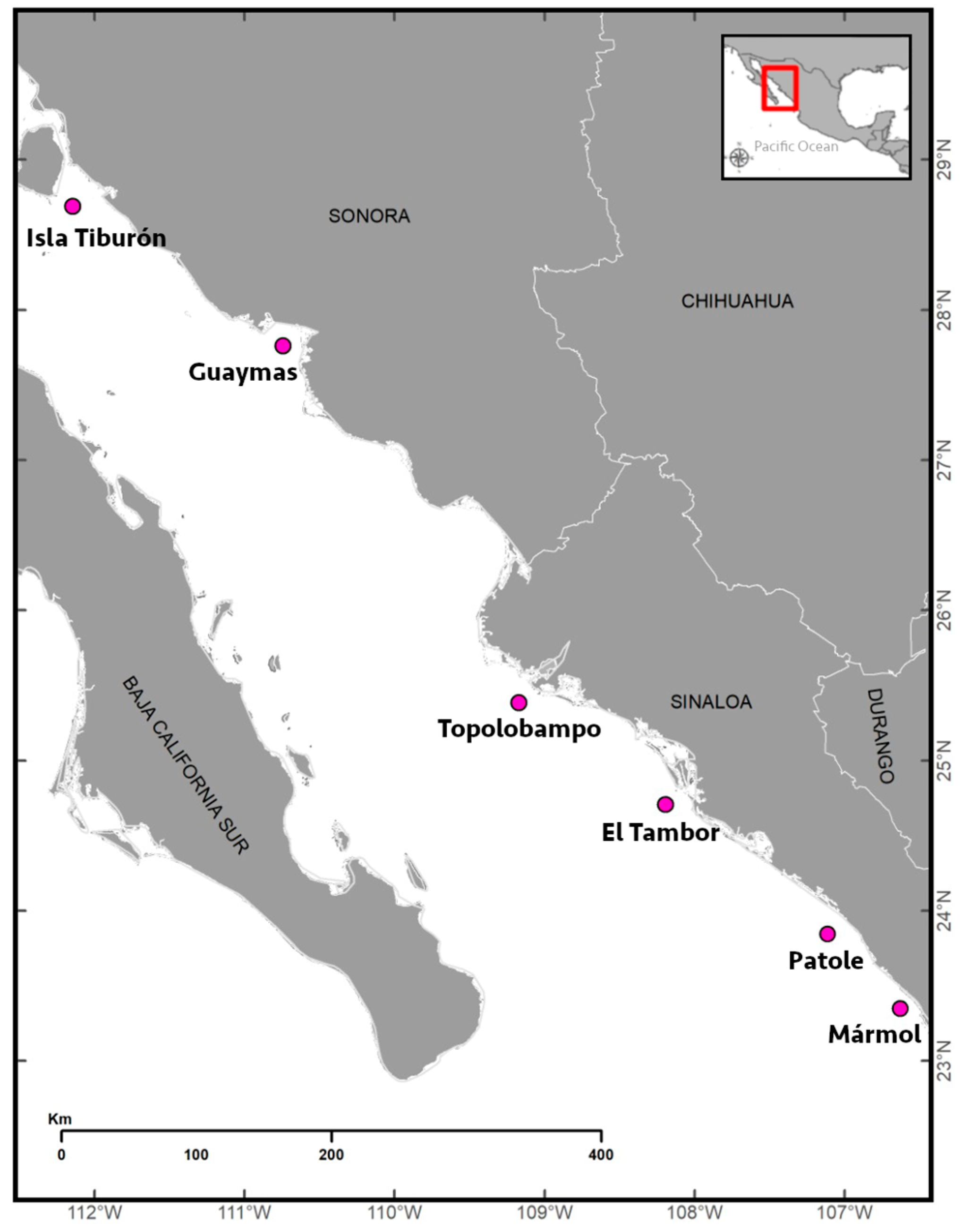
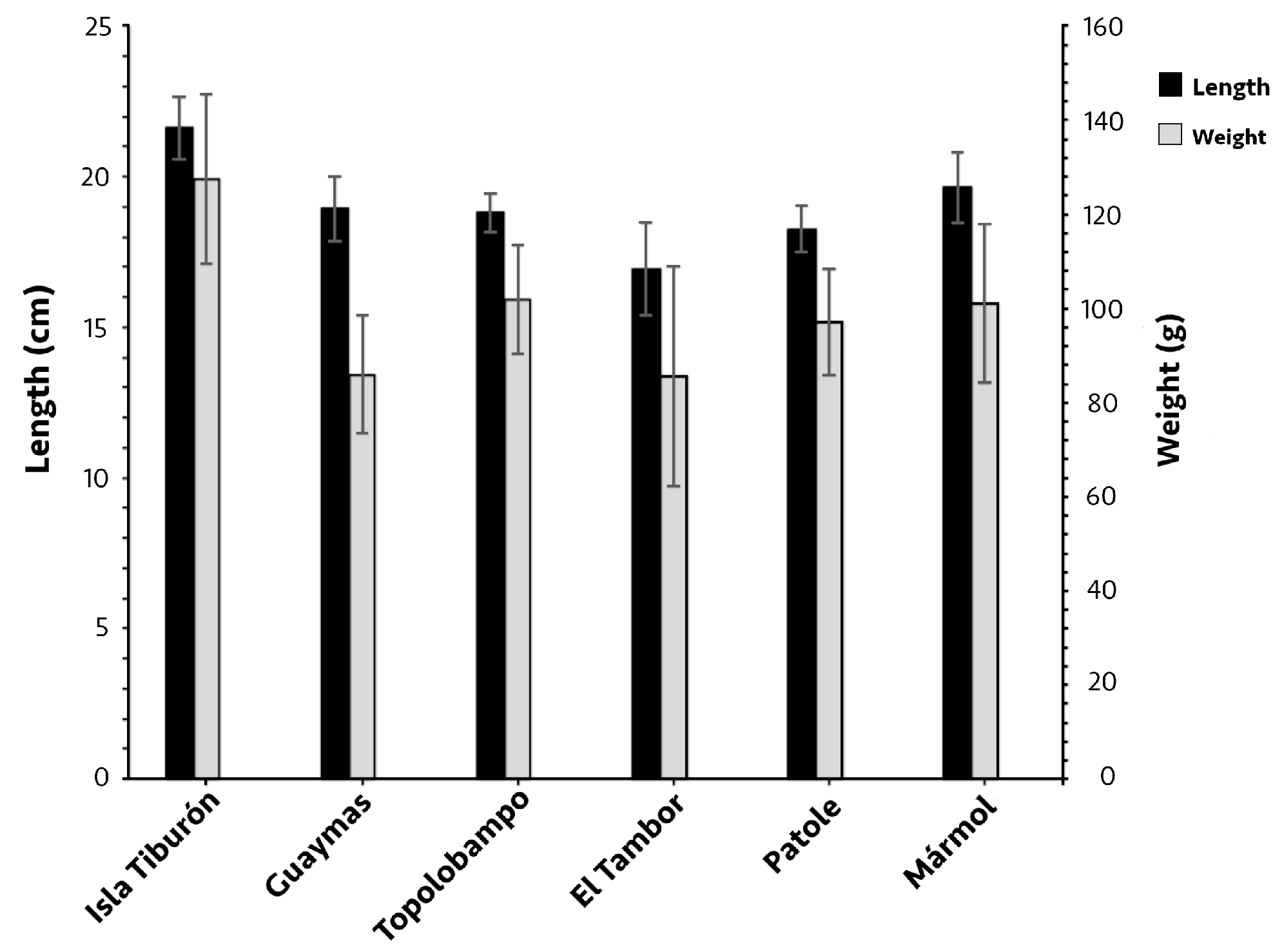

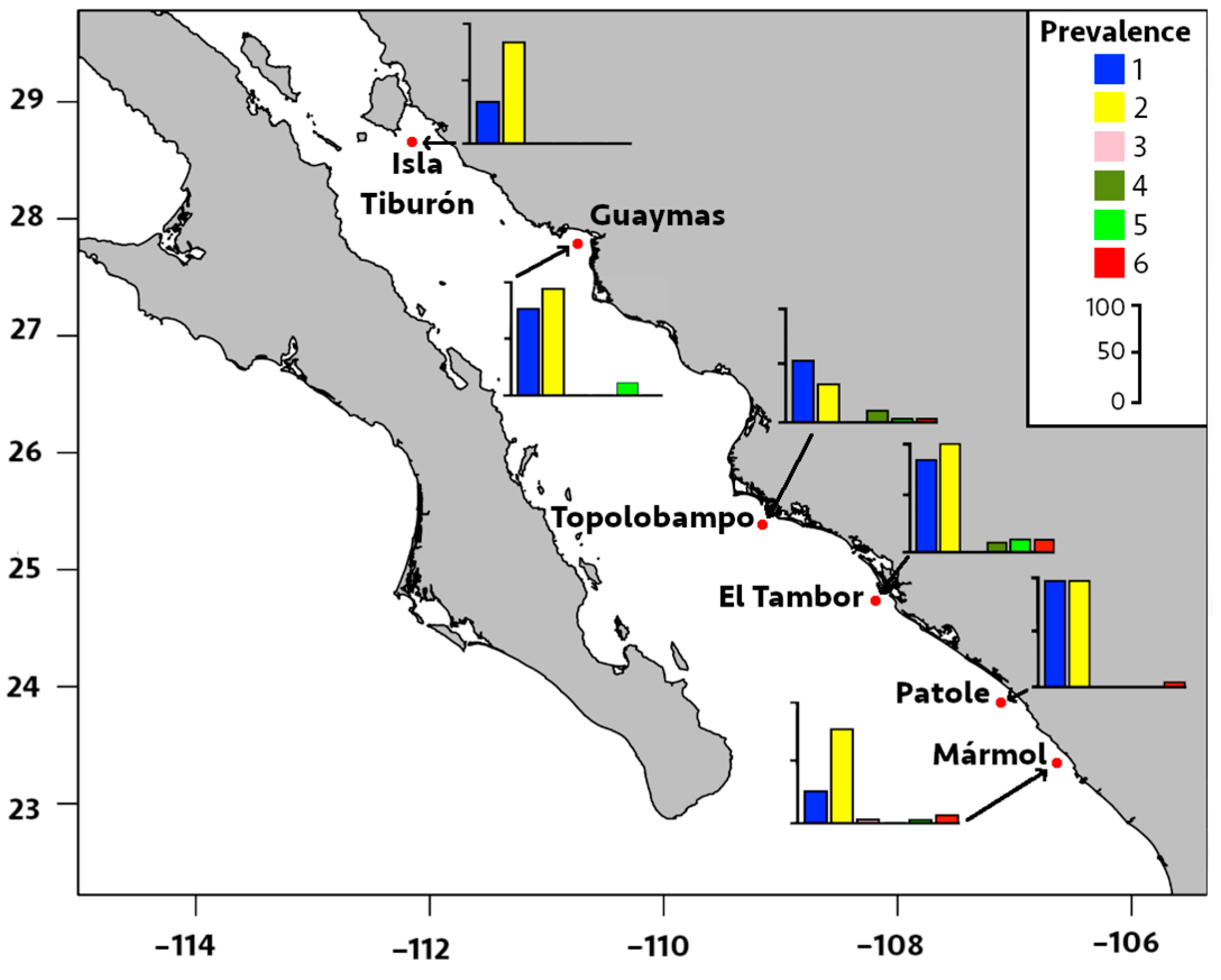
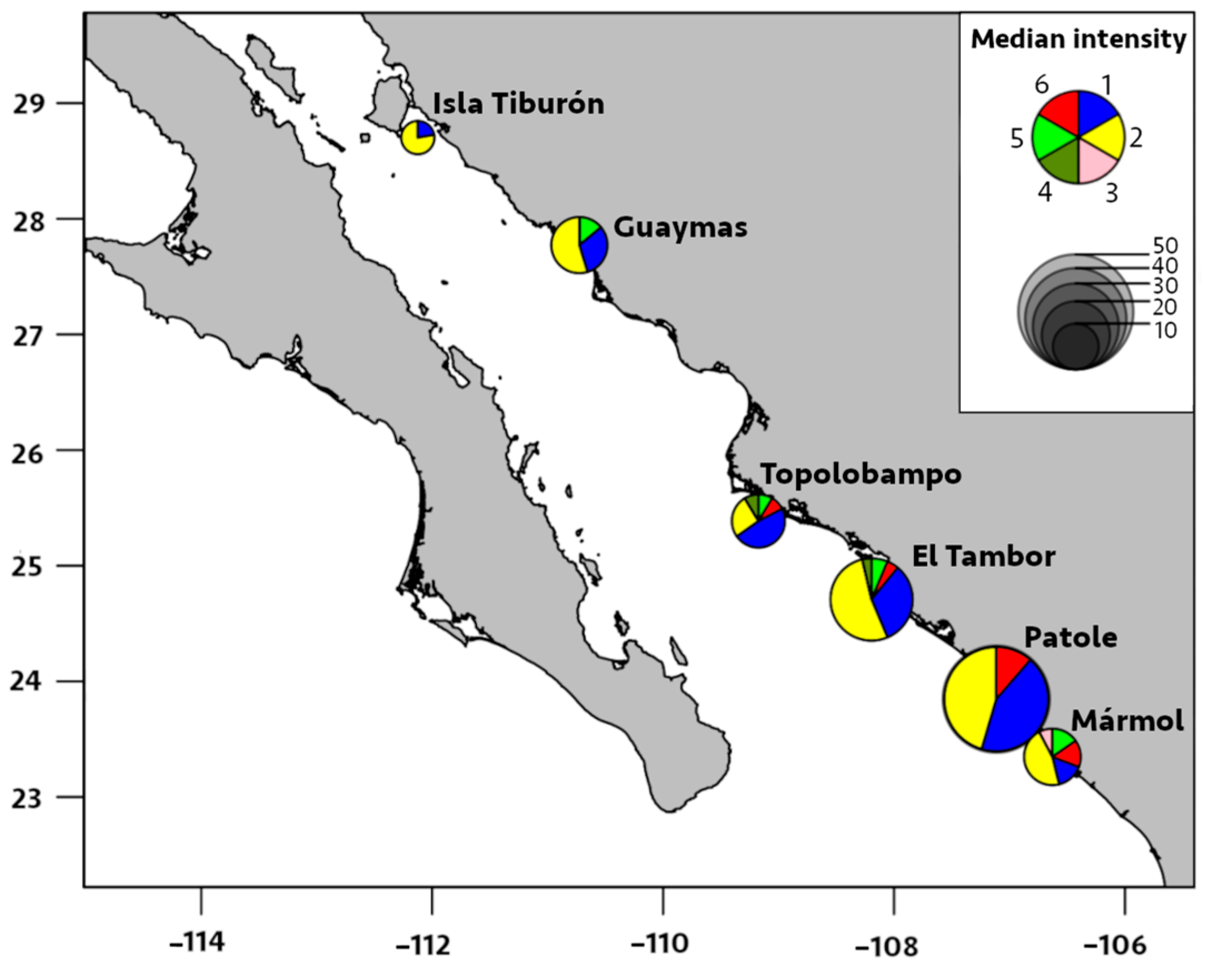
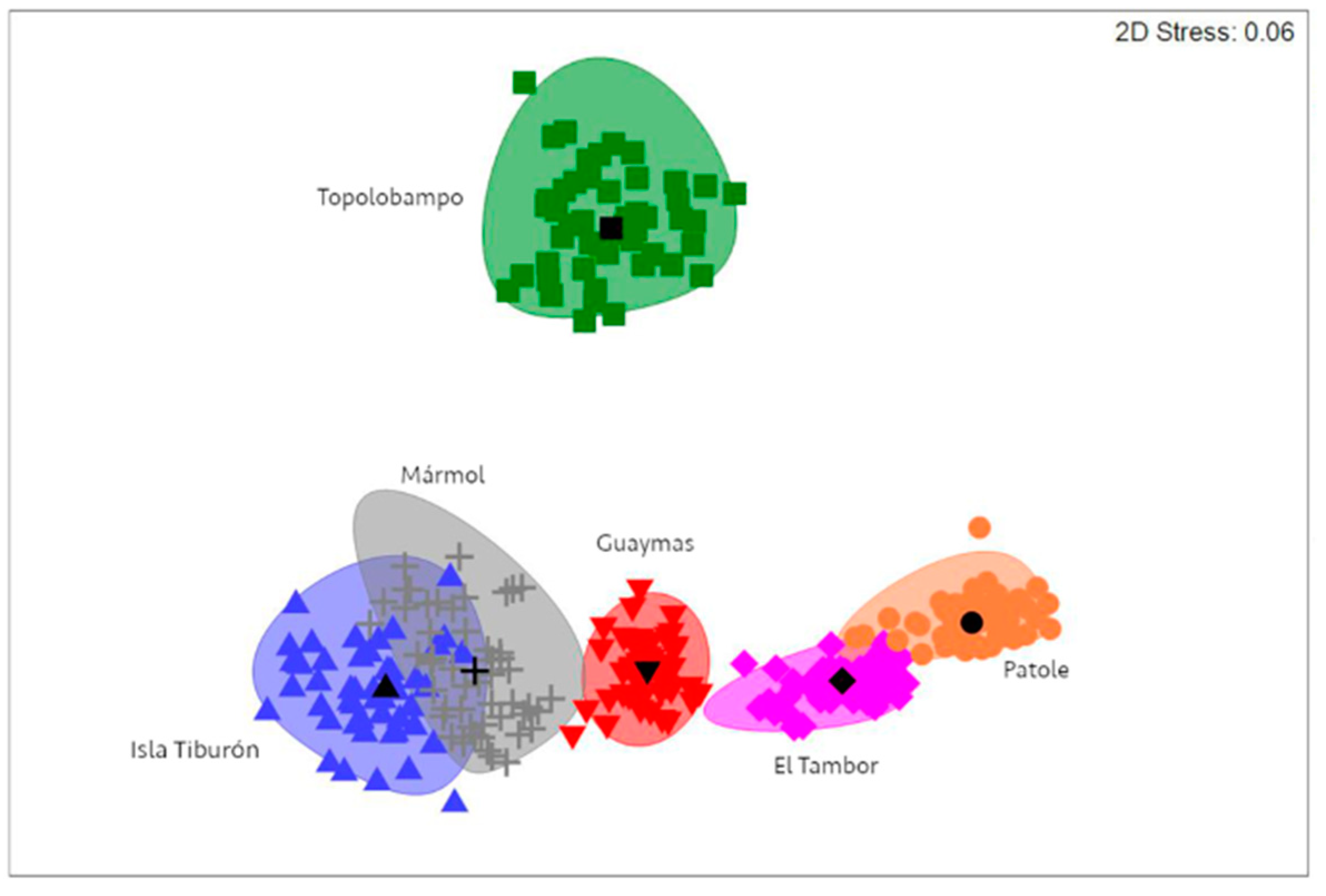
| Locality | Latitude, Longitude | Depth (m) | Temperature (°C) | n |
|---|---|---|---|---|
| Isla Tiburón | 28°70′15.3″ N, 112°12′46.9″ W | 45 | 30.2 | 38 |
| Guaymas | 27°77′20.9″ N, 110°72′53.3″ W | 47 | 28.8 | 57 |
| Topolobampo | 25°23′89.6″ N, 109°90′85.7″ W | 15 | 27.9 | 48 |
| El Tambor | 24°43′12.9″ N, 108°10′42.3″ W | 15 | 27.7 | 34 |
| Patole | 23°51′49.6″ N, 106°36′45.9″ W | 15 | 27.8 | 28 |
| Mármol | 23°21′46.1″ N, 106°36′45.9″ W | 15 | 27.9 | 52 |
| Parasite | Isla Tiburón | Guaymas | Topolobampo | El Tambor | Patole | Mármol | |
|---|---|---|---|---|---|---|---|
| Myosaccium ecaude | P% | 34(19–51) a,c | 75(62–85) b | 54(39–68) c | 85(68–95) b,d | 96(81–99) d | 26(15–41) a |
| MI | 1(1–2) a | 4(2–6) a,d | 5.5(2–8) c,d | 9(5–18) c | 19(9–26) b | 2(1–29) a,b,c | |
| Parahemiurus merus | P% | 84(68–94) a,b | 93(83–98) a, e | 33(20–48) c | 100(89–100) e | 96(81–99) a,e | 78(65–88) b,d |
| MI | 3.5(2–5) a,b | 7(5–9) a,e | 3(1–8) b,d | 14.5(10–23) f | 20(15–41) c,f | 6(5–10) e | |
| Pseudoterranova sp. | P% | 0 | 0 | 0 | 0 | 0 | 1(0–10) |
| MI | 0 | 0 | 0 | 0 | 0 | 1(0.9–1) | |
| Lepeophtheirus sp. | P% | 0 | 0 | 10(3–22) | 8(1–23) | 0 | 0 |
| MI | 0 | 0 | 1(0.7–1.2) | 1(0.9–1.1) | 0 | 0 | |
| Cribromazocraes cf. travassosi | P% | 0 | 10(4–21) | 2(0–11) | 11(3–27) | 0 | 1(0–10) |
| MI | 0 | 1.8(1–3) | 1(0.9–1.1) | 1.75(1.5–1.9) | 0 | 2(1.9–2) | |
| Mazocraeoides georgei | P% | 0 | 0 | 2(0–11) | 11(3–27) | 3(1–18) | 5(1–15) |
| MI | 0 | 0 | 1(0.9–1.01) | 1.25(1.1–1.3) | 5(4.6–5.3) | 2(1.8–2.1) |
| Data | Source | d.f. | SS | MS | Pseudo F | Pperm |
|---|---|---|---|---|---|---|
| Both parasites (Bray–Curtis similarity) | Host size | 1 | 26,768 | 26,768 | 14.23 | <0.01 |
| Locality | 5 | 85,006 | 17,001 | 9.03 | <0.01 | |
| Host size x Locality | 5 | 8686.60 | 1737.3 | 0.92 | >0.05 | |
| Residual | 245 | 4.60 e5 | 1880.9 | |||
| Total | 256 | 5.81 e5 |
Disclaimer/Publisher’s Note: The statements, opinions and data contained in all publications are solely those of the individual author(s) and contributor(s) and not of MDPI and/or the editor(s). MDPI and/or the editor(s) disclaim responsibility for any injury to people or property resulting from any ideas, methods, instructions or products referred to in the content. |
© 2023 by the authors. Licensee MDPI, Basel, Switzerland. This article is an open access article distributed under the terms and conditions of the Creative Commons Attribution (CC BY) license (https://creativecommons.org/licenses/by/4.0/).
Share and Cite
López-Moreno, D.G.; Vallarta-Zárate, J.R.F.; Marín-Enríquez, E.; Amezcua, F.; Morales-Serna, F.N. Looking for Parasites as Potential Biological Tags for Pacific Thread Herring, Opisthonema libertate (Günther, 1867) (Clupeiformes, Dorosomatidae), in the Gulf of California. Fishes 2023, 8, 336. https://doi.org/10.3390/fishes8070336
López-Moreno DG, Vallarta-Zárate JRF, Marín-Enríquez E, Amezcua F, Morales-Serna FN. Looking for Parasites as Potential Biological Tags for Pacific Thread Herring, Opisthonema libertate (Günther, 1867) (Clupeiformes, Dorosomatidae), in the Gulf of California. Fishes. 2023; 8(7):336. https://doi.org/10.3390/fishes8070336
Chicago/Turabian StyleLópez-Moreno, Dania Guadalupe, Juan Roberto Felipe Vallarta-Zárate, Emigdio Marín-Enríquez, Felipe Amezcua, and Francisco Neptalí Morales-Serna. 2023. "Looking for Parasites as Potential Biological Tags for Pacific Thread Herring, Opisthonema libertate (Günther, 1867) (Clupeiformes, Dorosomatidae), in the Gulf of California" Fishes 8, no. 7: 336. https://doi.org/10.3390/fishes8070336






